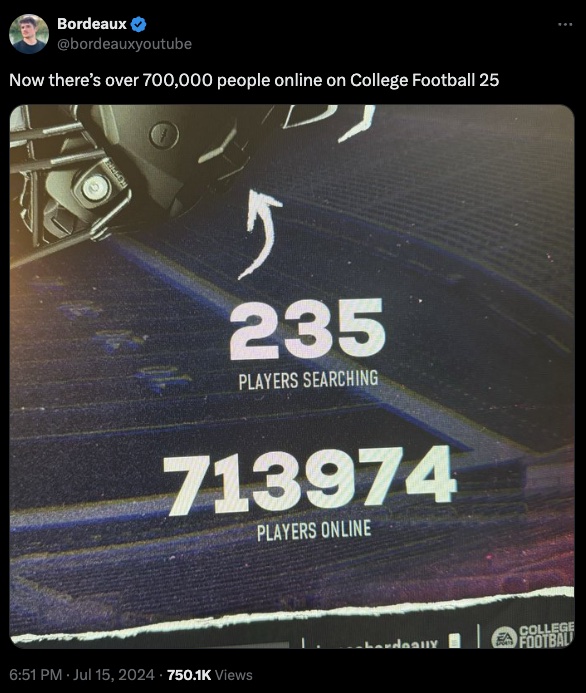
Gaming Infrastructure: How EA College Sports Football 25 Supported 700K Players
After ten years, EA Sports has brought back its college football game series with EA Sports College Football 25. The game’s launch on July 15th—for those who bought the $100 deluxe edition or used the EA Play 10-hour trial—witnessed over 700,000 concurrent players logged in across PS5 and Xbox Series X|S.
This incredible number highlights the game’s immense popularity and the critical need for latency-free gaming infrastructure. So how did EA support so many players? Let’s explore the gaming infrastructure essentials that allow for such a massive online event.
How can geographically distributed data centers provide a seamless gaming experience?
To handle the high demand, you need geographically distributed data centers to support a strong foundation. EA strategically places primary and secondary data centers in North America, South America, Africa, Europe, and Asia-Pacific to ensure the game’s core operations run smoothly.
These primary sites would be equipped with high-performance servers, capable of handling massive loads, while secondary data centers would be on standby to take over in case of failure.
But it doesn’t stop there.
To further reduce latency and improve performance, you need to deploy edge data centers in smaller, key locations. These edge centers act as local hubs, bringing the game closer to players and delivering a smooth, lag-free experience. The combination of primary, secondary, and edge data centers provides a resilient and responsive infrastructure.
What role does high-speed networking play in gaming infrastructure performance?
High-speed fiber optic connections form the backbone of gaming infrastructure, ensuring robust internet connectivity with multiple ISPs to prevent any single point of failure.
Content Delivery Networks (CDNs) like Akamai and Cloudflare play a crucial role in distributing content efficiently, reducing load times, and enhancing download speeds by caching game content closer to players.
What are the critical elements of servers and storage in gaming infrastructure?
Inside the data centers, you would need a mix of traditional physical servers and cloud-based instances to run the core game logic and databases. Virtualization with VMware and containerization with Docker and Kubernetes will optimize hardware utilization and streamline application deployment.
High-speed NVMe SSDs and centralized Storage Area Networks (SAN) will provide low-latency, high-speed data access. Meanwhile, cloud storage solutions like AWS S3 and Google Cloud Storage will securely store game assets, logs, and backups.
How do databases manage player data and game statistics?
Managing player data and game statistics requires serious database solutions. Relational databases like MySQL, PostgreSQL, and Microsoft SQL Server, both on-premises and cloud-based via Amazon RDS and Google Cloud SQL will handle structured data.
For unstructured data, NoSQL databases like Amazon DynamoDB and Google Cloud Firestore will provide fast and flexible data management.
Why are load balancers essential for managing traffic?
At the heart of managing such a large-scale online event are load balancers. Hardware load balancers from F5 and Citrix will distribute data center traffic, and virtual load balancers will manage cloud traffic.
Global load balancers will direct players to the nearest or least congested data center to optimize performance and user experience.
These load balancers ensure that no single server becomes overwhelmed by distributing the traffic load evenly across multiple servers. This not only enhances performance but also provides redundancy—if one server fails, others can take over without affecting the gaming experience.
What security tools are used to monitor and manage gaming infrastructure?
Security is crucial in any online gaming environment. Advanced firewall systems from Palo Alto will protect the network, while DDoS protection services like AWS Shield, Cloudflare, and Radware will safeguard against malicious attacks.
Encryption, both in transit and at rest, will ensure data privacy, with TLS/SSL certificates and Hardware Security Modules (HSM) managing encryption keys.
Real-time monitoring tools like Prometheus and Grafana—alongside comprehensive solutions like Datadog—will keep a vigilant eye on the infrastructure.
VMware vSphere and Kubernetes Dashboard will facilitate efficient management of virtualized and containerized environments.
In the event of catastrophic failure, backup solutions from Veeam and AWS Backup will ensure data is securely backed up, while secondary data centers and cloud-based disaster recovery services like AWS Disaster Recovery will be ready for rapid failover.
How does HorizonIQ support the gaming industry?
At HorizonIQ, we understand the latency, security, and scalability challenges the gaming industry faces. Our clients trust our bare metal servers, firewalls, and DDoS mitigation to provide the flexibility and reliability needed for their gaming infrastructures—but that’s not all.
Our engineering team recently developed new load balancers to distribute traffic intelligently across gaming environments to prevent bottlenecks, improve application availability, and enable global scalability.
With virtual and dedicated load balancers available across all our data centers, we offer flexible options to suit various needs and budgets.
Benefits of HorizonIQ Load Balancers:
- Cost-effective: Our solutions provide high performance at a lower cost compared to competitors like F5.
- Fully managed: Our experts ensure your load balancers fully optimize your infrastructure.
- Scalable and reliable: Seamless performance and minimal downtime with intelligent traffic routing.
Load Balancer options:
| Service Type | Introductory Monthly Fee |
| Virtual 200k | $99* |
| Virtual 500k | $149* |
| Dedicated 500k | $199 |
| Dedicated 1MM | $349 |
Additionally, our newly enhanced network carrier diversity with providers like Cogent Communications and Zayo Group ensures less network downtime.
Ready to elevate your gaming infrastructure:? Check out our new load balancer options.




